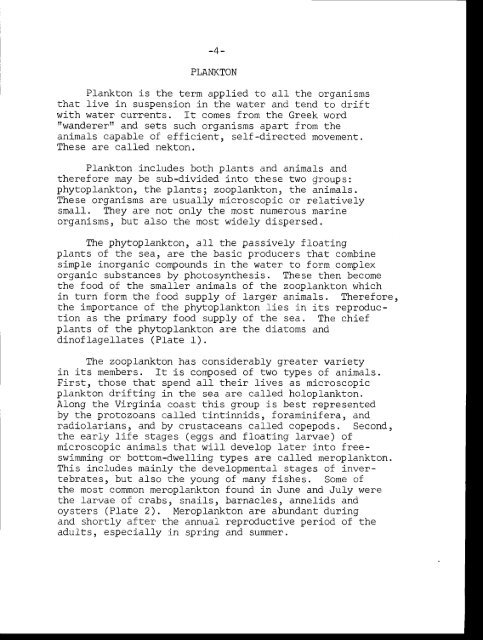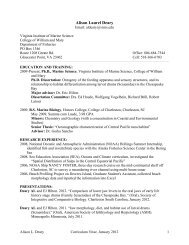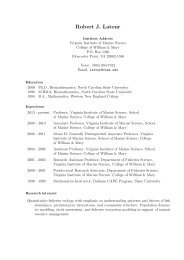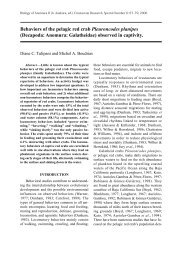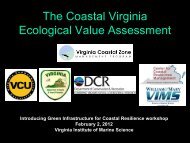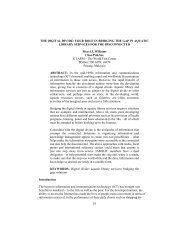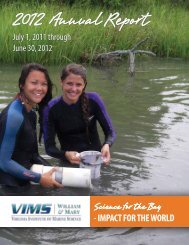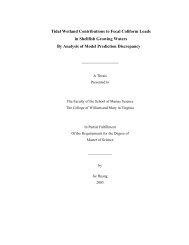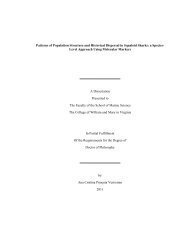Guide to the identification of marine plants and invertebrate animals ...
Guide to the identification of marine plants and invertebrate animals ...
Guide to the identification of marine plants and invertebrate animals ...
Create successful ePaper yourself
Turn your PDF publications into a flip-book with our unique Google optimized e-Paper software.
-4-<br />
PLANKTON<br />
Pl-ank<strong>to</strong>n is <strong>the</strong> term applied <strong>to</strong> al-I <strong>the</strong> organisms<br />
that l-ive in suspension in <strong>the</strong> water <strong>and</strong> tend <strong>to</strong> drift<br />
with water cuments. It comes f rom <strong>the</strong> Greek word<br />
trw<strong>and</strong>ererrr <strong>and</strong> sets such organisms apart from <strong>the</strong><br />
animal-s capable <strong>of</strong> efficient, self-directed movement.<br />
These are cal-l-ed nek<strong>to</strong>n.<br />
Pl-ank<strong>to</strong>n includes both <strong>plants</strong> <strong>and</strong> animal-s <strong>and</strong><br />
<strong>the</strong>refore may be sub-divided in<strong>to</strong> <strong>the</strong>se two giroups:<br />
phy<strong>to</strong>plank<strong>to</strong>n, <strong>the</strong> <strong>plants</strong>; zooplank<strong>to</strong>n, <strong>the</strong> animal-s.<br />
These organi-sms are usually microscopic or relatively<br />
cm:l<br />
'l 'Tlrorr :ro n^l- nnlrr t-ho<br />
srv rrvv vrr+J<br />
699l nUmefOUS mafine<br />
organisms, but al-so <strong>the</strong> most widely dispersed.<br />
The phy<strong>to</strong>plank<strong>to</strong>n, a]l- <strong>the</strong> passj.vely floating<br />
<strong>plants</strong> <strong>of</strong> <strong>the</strong> sea, are <strong>the</strong> basic producers that combine<br />
simple inorganic compounds in <strong>the</strong> water <strong>to</strong> form complex<br />
organic substances by pho<strong>to</strong>syn<strong>the</strong>sis. These <strong>the</strong>n become<br />
<strong>the</strong> food <strong>of</strong> <strong>the</strong> smal-l-er anj.mals <strong>of</strong> <strong>the</strong> zooplank<strong>to</strong>n which<br />
in turn form <strong>the</strong> food supply <strong>of</strong> larger animal-s. Therefore,<br />
<strong>the</strong> importance <strong>of</strong> <strong>the</strong> phy<strong>to</strong>plank<strong>to</strong>n lies in its reproduction<br />
as <strong>the</strong> primary food supply <strong>of</strong> <strong>the</strong> sea. The chief<br />
pl-ants <strong>of</strong> <strong>the</strong> phy<strong>to</strong>plank<strong>to</strong>n are <strong>the</strong> dj.a<strong>to</strong>ms <strong>and</strong><br />
din<strong>of</strong> lagel-l-ates (Plate l-) .<br />
The zoopl-ank<strong>to</strong>n has considerabty greater variety<br />
in its members. It is composed <strong>of</strong> two types <strong>of</strong> anj.mal-s.<br />
First, those that spend ai-l- <strong>the</strong>ir l-ives as microscopic<br />
plank<strong>to</strong>n drifting in <strong>the</strong> sea are cal-l-ed holoplank<strong>to</strong>n.<br />
Along <strong>the</strong> Virgi-ni-a coast this group is best represented<br />
by <strong>the</strong> pro<strong>to</strong>zoans cal-l-ed tintinnids, f oraminif era, <strong>and</strong><br />
radiol-arians, <strong>and</strong> by crustaceans call-ed copepods. Second,<br />
<strong>the</strong> early life stages (eggs <strong>and</strong> floating larvae) <strong>of</strong><br />
microscopic <strong>animals</strong> that wil-l- develop l-ater in<strong>to</strong> freeswimming<br />
or bot<strong>to</strong>rn-dwel-ling types are cal-l-ed meropl-ank<strong>to</strong>n.<br />
This includes mainly <strong>the</strong> developmental stages <strong>of</strong> <strong>invertebrate</strong>s,<br />
but al-so <strong>the</strong> young <strong>of</strong> many fishes. Some <strong>of</strong><br />
<strong>the</strong> most cornmon meroplank<strong>to</strong>n found in .June <strong>and</strong> .Iuly were<br />
<strong>the</strong> larvae <strong>of</strong> crabs, snails, barnacles, annel-ids <strong>and</strong><br />
oysters (Pl-ate 2). Meroplank<strong>to</strong>n are abundant during<br />
<strong>and</strong> shortly after <strong>the</strong> annual reproductive period <strong>of</strong> <strong>the</strong><br />
adul-ts, especially in spring <strong>and</strong> summer.


